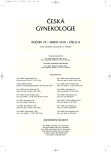Shoulder dystocia during vaginal delivery
Authors:
Lukáš Hruban 1
; M. Procházka 2; Petr Janků 1
Authors‘ workplace:
Gynekologicko-porodnická klinika MU a FN Brno, přednosta prof. MUDr. P. Ventruba, DrSc.
1; Gynekologicko-porodnická klinika LF UP a FN Olomouc, přednosta doc. MUDr. R. Pilka, Ph. D.
2
Published in:
Ceska Gynekol 2010; 75(4): 274-279
Overview
Shoulder dystocia is defined as a complication of vaginal delivery that requires additional obstetric manoeuvres to release the shoulders of the baby. Reported incidence of shoulder dystocia is around 0.6-1.4%. Serious perinatal morbidity is associated with this type of complication. Brachial plexus injuries are one of the most important fetal complications of shoulder dystocia. Some cases results in permanent brachial plexus dysfunction. A high level of awareness and training for all birth attendants is recommended. The purpose of this article is to review the current evidence regarding the possible prediction and management of shoulder dystocia.
Key words:
shoulder dystocia, brachial plexus injuries.
Sources
1. Acker, D., Sachs, B., Friedman, E. Risk factors for shoulder dystocia. Obstet Gynecol 1985, 66, p. 476–480.
2. Bahar, AM. Risk factors and fetal outcome in cases of shoulder dystocia compared with normal deliveries of a similar birthweight. Br J Obstet Gynaecol 1996, 103, p. 868–872.
3. Baskett, TF., Allen, AC. Perinatal implications of shoulder dystocia. Obstet Gynecol 1995, p. 14–17.
4. Baxley, EG., Gobbo, RW. Shoulder dystocia. ALSO series. Am Fam Physician 2004, 69, p. 1707–1714.
5. Berghella, V. Obstetrics- evidence based guidelines, part 1. New York: Informa Healthcare Inc. 2009, p. 175–177.
6. Bruner, JP., Drummond, SB., Meenan, AL., Gaskin, IM. All-fours maneuver for reducing shoulder dystocia during labor. J Reprod Med 1998, 43, p. 439–443.
7. Buhimschi, CS., Buhimschi, IA., Malinow, A., Weiner, CP. Use of McRoberts’ position during delivery and increase in pushing efficiency. Lancet 2001, 358, p.470–471.
8. Cunningham, G., Leveno, KJ., Bloom, SL, et al. Williams Obstetrics-23rd Ed., New York: McGraw-Hill Books 2010, p. 481-484.
9. Focus Group Shoulder Dystocia. In: Confidential enquiries into stillbirths and deaths in infancy. Fifth annual report. London: Maternal and Child Health Research Consortium, 1998, p. 73-79.
10. Gherman, RB., et al. Obstetric maneuvres for shoulder dystocia and associated fetal Morbidity. Am J Obstet Gynecol, 1998, 178, p. 1126-1130.
11. Gherman, RB., et al. The McRobert’s maneuver for the alleviation of shoulder dystocia. Am J Obstet Gynecol, 1997, 178, p. 656-661.
12. Gherman, RB., Goodwin, TM., Ouzounian, JG., et al. Spontaneous vaginal delivery: a risk factor for Erb’s palsy? Am J Obstet Gynecol 1998, 178, p. 423–427.
13. Gherman, RB., Goodwin, TM., Ouzounian, JG., et al. Brachial plexus palsy associated with cesarean section: an in utero injury? Am J Obstet Gynecol 1997, 177, p. 1162–1164.
14. Ginsberg, NA., Moisidis, C. How to predict recurrent shoulder dystocia. Am J Obstet Gynecol 2001, 184, p. 1427–1430.
15. Gonik, B., Zhang, N., Grimm, MJ. Defining forces that are associated with shoulder dystocia: the use of a mathematic dynamic computer model. Am J Obstet Gynecol 2003, 188, p. 1068–1072.
16. Gross, TL., Sokol, RJ., Williams, T., Thompson, K. Shoulder dystocia: a fetal-physician risk. Am J Obstet Gynecol 1987, 156, p. 1408–1418.
17. Gurewitsch, ED., Donithan, M., Stallings, SP., et al. Episiotomy versus fetal manipulation in managing severe shoulder dystocia: a comparison of outcomes. Am J Obstet Gynecol 2004, 191, p. 911–916.
18. Lurie, S., Ben-Arie, Hagay, A. The ABC of shoulder dystocia management. Asia Oceania J Obstet Gynaecol 1994, 20, p. 195–197.
19. McFarland, MB., Langer, O., Piper, JM., Berkus, MD. Perinatal outcome and the type and number of maneuvers in shoulder dystocia. Int J Gynaecol Obstet 1996, 55, p. 219–224.
20. Naef, RW. 3rd., Morrison, JC. Guidelines for management of shoulder dystocia. J Perinatol 1994, 14, p. 435–441.
21. Poggi, SH., Spong, CY., Allen, RH. Prioritizing posterior arm delivery during severe shoulder dystocia. Obstet Gynecol 2003, 101, p. 1068–1072.
22. RCOG Guideline No.42, December 2005.
23. Sandberg, EC. The Zavanelli maneuver: a potentially revolutionary method for the resolution of shoulder dystocia. Am J Obstet Gynecol 1985, 152, p. 479–484.
24. Spellacy, WN. The Zavanelli maneuver for fetal shoulder dystocia. Three cases with poor outcomes. J Reprod Med 1995, 40, p. 543–544.
Labels
Paediatric gynaecology Gynaecology and obstetrics Reproduction medicineArticle was published in
Czech Gynaecology

2010 Issue 4
Most read in this issue
- Shoulder dystocia during vaginal delivery
- Repair of the 3rd and 4th degree obstetric perineal tear
- Perinatal brachial plexus palsy
- Complications of radical oncogynecological operations
